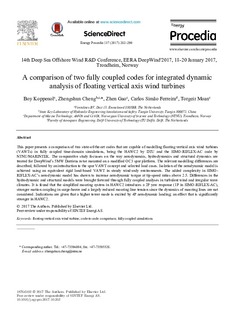| dc.contributor.author | Koppenol, Boy | |
| dc.contributor.author | Cheng, Zhengshun | |
| dc.contributor.author | Gao, Zhen | |
| dc.contributor.author | Ferreira, Carlos Simão | |
| dc.contributor.author | Moan, Torgeir | |
| dc.date.accessioned | 2018-01-03T11:31:14Z | |
| dc.date.available | 2018-01-03T11:31:14Z | |
| dc.date.created | 2018-01-02T08:01:05Z | |
| dc.date.issued | 2017 | |
| dc.identifier.citation | Energy Procedia. 2017, 137 282-290. | nb_NO |
| dc.identifier.issn | 1876-6102 | |
| dc.identifier.uri | http://hdl.handle.net/11250/2474321 | |
| dc.description.abstract | This paper presents a comparison of two state-of-the-art codes that are capable of modelling floating vertical axis wind turbines (VAWTs) in fully coupled time-domain simulations, being the HAWC2 by DTU and the SIMO-RIFLEX-AC code by NTNU/MARINTEK. The comparative study focusses on the way aerodynamics, hydrodynamics and structural dynamics are treated for DeepWind’s 5MW Darrieus rotor mounted on a modified OC3 spar platform. The relevant modelling differences are described, followed by an introduction to the spar VAWT concept and selected load cases. Isolation of the aerodynamic model is achieved using an equivalent rigid land-based VAWT in steady wind-only environments. The added complexity in SIMO-RIFLEX-AC’s aerodynamic model has shown to increase aerodynamic torque at tip-speed ratios above 2.5. Differences in the hydrodynamic and structural models were brought forward through fully coupled analyses in turbulent wind and irregular wave climates. It is found that the simplified mooring system in HAWC2 introduces a 2P yaw response (1P in SIMO-RIFLEX-AC), stronger motion coupling in surge-heave and a largely reduced mooring line tension since the dynamics of mooring lines are not considered. Indications are given that a higher tower mode is excited by 4P aerodynamic loading; an effect that is significantly stronger in HAWC2. | nb_NO |
| dc.language.iso | eng | nb_NO |
| dc.publisher | Elsevier | nb_NO |
| dc.rights | Attribution-NonCommercial-NoDerivatives 4.0 Internasjonal | * |
| dc.rights.uri | http://creativecommons.org/licenses/by-nc-nd/4.0/deed.no | * |
| dc.title | A comparison of two fully coupled codes for integrated dynamic analysis of floating vertical axis wind turbines | nb_NO |
| dc.type | Journal article | nb_NO |
| dc.type | Peer reviewed | nb_NO |
| dc.description.version | publishedVersion | nb_NO |
| dc.source.pagenumber | 282-290 | nb_NO |
| dc.source.volume | 137 | nb_NO |
| dc.source.journal | Energy Procedia | nb_NO |
| dc.identifier.doi | 10.1016/j.egypro.2017.10.352 | |
| dc.identifier.cristin | 1533377 | |
| dc.description.localcode | © 2017 The Author(s). Published by Elsevier Ltd. This is an open access article under the CC BY-NC-ND license (http://creativecommons.org/licenses/by-nc-nd/4.0/). | nb_NO |
| cristin.unitcode | 194,64,20,0 | |
| cristin.unitname | Institutt for marin teknikk | |
| cristin.ispublished | true | |
| cristin.fulltext | original | |
| cristin.qualitycode | 1 | |

